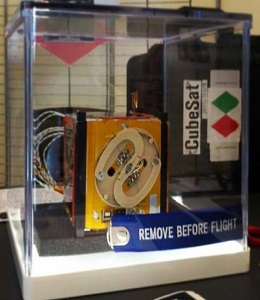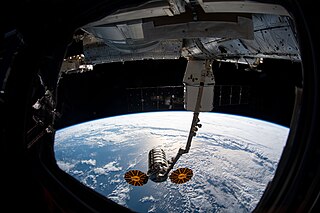
A CubeSat is a class of miniaturized satellite with a form factor of 10 cm (3.9 in) cubes. CubeSats have a mass of no more than 2 kg (4.4 lb) per unit, and often use commercial off-the-shelf (COTS) components for their electronics and structure. CubeSats are deployed into orbit from the International Space Station, or launched as secondary payloads on a launch vehicle. As of December 2023, more than 2,300 CubeSats have been launched.

A small satellite, miniaturized satellite, or smallsat is a satellite of low mass and size, usually under 1,200 kg (2,600 lb). While all such satellites can be referred to as "small", different classifications are used to categorize them based on mass. Satellites can be built small to reduce the large economic cost of launch vehicles and the costs associated with construction. Miniature satellites, especially in large numbers, may be more useful than fewer, larger ones for some purposes – for example, gathering of scientific data and radio relay. Technical challenges in the construction of small satellites may include the lack of sufficient power storage or of room for a propulsion system.

Radio Aurora Explorer (RAX) is the first National Science Foundation sponsored CubeSat mission. The RAX mission is a joint effort between SRI International in Menlo Park, California and the University of Michigan in Ann Arbor, Michigan. The chief scientist at SRI International, Dr. Hasan Bahcivan, led his team at SRI to develop the payload while the chief engineer, Dr. James Cutler, led a team of students to develop the satellite bus in the Michigan Exploration Laboratory. There are currently two satellites in the RAX mission.

SwissCube-1 is a Swiss satellite operated by École Polytechnique Fédérale de Lausanne (EPFL). The spacecraft is a single unit CubeSat, which was designed to conduct research into nightglow within the Earth's atmosphere, and to develop technology for future spacecraft. It has also been used for amateur radio. It was the first Swiss satellite to be launched.

BeeSat-1 or Berlin Experimental and Educational Satellite 1, is a German satellite operated by the Technical University of Berlin. The spacecraft is a single unit CubeSat, which was designed to test systems intended for use on future spacecraft, including a new design of reaction wheel. It has also been used for amateur radio, and is equipped with a small camera.

Aalto-1 is a Finnish research nanosatellite, created by students of Aalto University. Based on the CubeSat architecture, it was originally scheduled to be launched in 2013, it was launched on 23 June 2017. It is Finland's first student satellite project and indigenously produced satellite. As of 2021, the satellite is operational.
M-Cubed is a miniaturized satellite built by students at the University of Michigan in a joint project run by the Michigan Exploration Laboratory (MXL) and JPL. It is an example of the popular CubeSat design for amateur satellites. It was launched from Vandenberg Air Force Base on October 28, 2011 atop a Delta II rocket. M-Cubed was launched as a secondary payload to the Suomi NPP satellite, along with AubieSat-1, DICE-1, DICE-2, Explorer-1 Prime, and RAX-2.

RAX-2 is a CubeSat satellite built as a collaboration between SRI International and students at the University of Michigan College of Engineering. It is the second spacecraft in the RAX mission. The RAX-1 mission ended after approximately two months of operation due to a gradual degradation of the solar panels that ultimately resulted in a loss of power. RAX team members applied the lessons learned from RAX-1 to the design of a second flight unit, RAX-2, which performs the same mission concept of RAX-1 with improved bus performance and additional operational modes. Science measurements are enhanced through interactive experiments with high power ionospheric heaters where FAI will be generated on demand.
The Dynamic Ionosphere CubeSat Experiment (DICE) is a scientific mission consisting of two Miniaturized Satellites DICE-1 and DICE-2 flying in formation. The satellites are an unusual 1.5U variant of the CubeSat design for microsatellites. Both satellites were launched from Vandenberg Air Force Base in October 2011 atop a Delta II rocket. This was a multi-payload mission with four other CubeSats, AubieSat-1, M-Cubed, Explorer-1_Prime and RAX-2.

Colorado Student Space Weather Experiment (CSSWE) was the sixth National Science Foundation sponsored CubeSat mission. It was built by students at the University of Colorado at Boulder with advising from professionals at the Laboratory for Atmospheric and Space Physics. The CSSWE mission was a joint effort by the University of Colorado's Department of Aerospace Engineering Sciences and Laboratory for Atmospheric and Space Physics. The mission principal investigator was Prof. Xinlin Li, and the Co-PIs are Prof. Scott Palo and Dr. Shri Kanekal. The project manager for the project was Dr. Lauren Blum, the system engineer was Dr. David Gerhardt, and the instrument scientist was Dr. Quintin Schiller.
Technology Education Satellite (TechEdSat) is a successful nano-sat flight series conducted from the NASA Ames Research Center in collaboration with numerous universities. While one of the principal aims has been to introduce young professionals and university students to the practical realm of developing space flight hardware, considerable innovations have been introduced. In addition, this evolving flight platform has tested concepts for Low Earth Orbit (LEO) sample return, as well as planetary nano-sat class mission concepts.
PW-Sat is a series of Polish CubeSats designed and built by students at the Warsaw University of Technology in conjunction with the Faculty of Power and Aeronautical Engineering of Warsaw University of Technology, the Space Research Centre of Polish Academy of Sciences, and the European Space Agency. As of January 1, 2024, there have been 2 PW-Sats with a third in development. The first PW-Sat was the first Polish artificial satellite which was launched 13 February 2012 from ELA-1 at Guiana Space Centre aboard Italian-built Vega launch vehicle during its maiden voyage. After their graduation, the team that developed the original PW-Sat have also worked to develop the subsequent missions, establishing a private company named PW-Sat to design and manufacturer the PW-Sats, all of which test novel deorbiting methods, with the overall goal of the program to develop solutions to space debris.

AAUSat-3,, is the third CubeSat built and operated by students from the Aalborg University in Denmark. It was launched on 25 February 2013 from the Satish Dhawan Space Centre in India on a Polar Satellite Launch Vehicle (PSLV) launch vehicle (PSLV-C20). AAUSat-3 carries two Automatic Identification System receivers as the main payload.
The Illinois Observing Nanosatellite (ION) is the first CubeSat mission developed by the students of University of Illinois at Urbana-Champaign. The satellite was lost in the failure of the Dnepr launch on 26 July 2006. Completed in April 2005 as a part of the Illinois Tiny Satellite Initiative, the satellite took almost four years to be designed, built and tested by an interdisciplinary team of student engineers. The payloads included a photometer, a micro-thruster and a camera.
Space Tethered Autonomous Robotic Satellite II or STARS-II, was a nanosatellite built by Japan's Kagawa University to test an electrodynamic tether in low Earth orbit, a follow-on to the STARS mission.

The Nanoracks CubeSat Deployer (NRCSD) is a device to deploy CubeSats into orbit from the International Space Station (ISS).

e-st@r-II is a miniaturized satellite designed and built by Polytechnic University of Turin, as part of the "Fly Your Satellite" program of the European Space Agency.

NG-11, previously known as OA-11, is the twelfth flight of the Northrop Grumman robotic resupply spacecraft Cygnus and its eleventh flight to the International Space Station under the Commercial Resupply Services (CRS-1) contract with NASA. The mission launched on 17 April 2019 at 20:46:07 UTC. This is the last mission from the extended CRS-1 contract; follow-up missions are part of the CRS-2 contract. Cygnus NG-11 was also the first mission to load critical hardware onto Cygnus within the last 24 hours prior to launch, a new Antares feature.
Educational Launch of Nanosatellites (ELaNa) is an initiative created by NASA to attract and retain students in the science, technology, engineering and mathematics disciplines. The program is managed by the Launch Services Program (LSP) at NASA's Kennedy Space Center in Florida.












